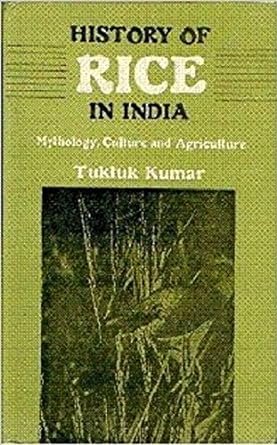
HISTORY OF RICE IN INDIA
Mythology, Culture and Agriculture
 Rice is not only the staple diet of the majority of Indian population, it is a significant part of the country’s cultural heritage. In mythology, religious rituals and social
Rice is not only the staple diet of the majority of Indian population, it is a significant part of the country’s cultural heritage. In mythology, religious rituals and social
ceremonies rice is the most sought after and widely used item.
The present work deals with rice in the total historical, cultural and agricultural aspects. Its main
distinguishing feature is the separate treatment of a particular cereal in the agricultural complex of the
sub-continent, which has tremendous economic as well as socio-cultural significance. This has not been attempted earlier.
Further, the treatment is of a multidisciplinary nature and seeks to provide a more rounded picture of the subject. This, too, is a novel approach to the study of agricultural history. moreso as it is detailed and comprehensive.
It also paves the way for similar studies of other agricultural products which may subsequently be collat ed into an extremely useful compencilium. This is specially so in view of the fact that agriculture has been anc continued to be the backbone of the Indian economy and ethos. So far the subject has not received scholastic attention commensurate with its importance. This book fills in the vacuum. Students of Indian history, archaeology, civilization and culture will find the book equally informa tive as, those interested in agriculture and cultivation.
About Author
Dr. Ms. Tuktuk Kumar, nee Ghosh, was born and educated at Patna. Later, she studied at the University of Delhi, obtaining her Ph.D. degree in 1985, in history.
Between November 1979 and August 1981, she was a lecturer at Hindu College, Delhi. In 1981 September, she joined the Indian Administrative Service and was allotted the West Bengal Cadre. She has since been working in different capacities in the state government.
Apart from academics, Dr. Kumar has a variety of cultural interests, in which she endeavours to keep herself involved.
Foreword
The present book is the first major work on the history of a single crop in India. That it is on such an important crop as rice gives it an added importance. What also lends this work distinction is the fact that it has tried to encompass all categories of relevant data-archaeology, literature, botany, ethnography and linguistics. On each of these categories there has been a reasonably thorough and systematic discussion. What has emerged in the end is a precise and analytical picture of the history of rice in the protohistoric and early historic periods of India. In the historiography of studies on history of agriculture in India the present venture by Dr. Ms. Tuk-Tuk Kumar (nee Ghosh) must be considered a highly successful major attempt.
In recent years the study of the history of Indian agricul- ture has been primarily devoted to the identification of plant and crop remains found in archaeological excavations. Pro- fessor Vishnu-Mittre of the Birbal Sahni Institute of Palaeobo- tany in Lucknow has played a stellar role in this regard, and after his retirement the mantle has fallen on Dr. K.S. Saraswat (Lucknow), Dr. G.M. Buth (Srinagar) and Dr. M.D. Kajale (Pune). It will, however, be quite incorrect to imagine that the archaeological records of plant and crop remains in India are in any sense complete or even adequate.
The number of scholars involved in this kind of study is quite marginal in such a large country as India. I remember
that I could not get a leaf impression on clay dating probably around 1000 B.C. identified in a major university department of Botany. At the same time the importance of synthesizing the presently available data is always there and I am thankful to Ms Kumar that she gave her best in the course of her Ph.D work with me. What stands out in this work is her fairly exhaustive analysis of the different types of sources. It is surely possible to dispute some points raised by her but this work is likely to remain unparalleled as a richly documented history of rice in early India for some years to come.
It had been my privilege to be associated with this work from its inception to conclusion and it gives me great pleasure that it is now published.
Dilip K. Chakraborti
